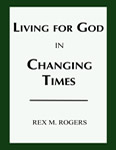Have you ever felt unsafe in your church? Have you been present when a stranger loudly disrupted the service? Have you thought about what you would do if a threat develops in your church?
Hi, I’m Rex Rogers and this is episode #74 of Discerning What Is Best, a podcast applying unchanging biblical principles in a rapidly changing world, and a Christian worldview to current issues and everyday life.
I was taken to church by my Christian parents from before I was born and certainly every opportunity thereafter. During my adult life, I’ve attended thousands of services of one kind or another in a variety of churches across the country.
Only once in all those years have I directly witnessed a person disrupt a service by yelling, screaming actually, and making threatening gestures toward attendees and the pastor. Thankfully, this person was not armed, nor did he hurt anyone before a few men were able to usher him out of the auditorium. And I do mean “usher,” because in this case the disturbed man cooperated, those surrounding him did not manhandle him, and no violence occurred.
I tell this story to tweak your memories about when you may have experienced something similar or something far more dangerous. Overall, churches, synagogues, mosques and other “faith-based” organizations enjoy a record of safety and tranquility. So don’t be afraid to go to church.
However, as anyone knows who’s paid attention at all, safety threats in houses of worship, just like with malls and schools, have increased in the past thirty years.
Some have called these incidents “hate crimes,” and no doubt some were. But, “jarringly, most victims of church shootings likely know their attacker. Nearly half of the offenders (48%) were affiliated with the church…and nearly a quarter (23%) involved ‘intimate partners,’ such as wives, girlfriends and husbands.”
“In (Carl Chinn’s book, Evil Invades Sanctuary, The Case for Security in Faith-based Organizations, in his) dataset, robberies account for more than a quarter of homicides within houses of worship, followed by fights between domestic partners (16%) and personal conflicts between people who do not live together (14%).”
“Chinn found that more than 10% of all homicides at houses of worship involve mental illness. Religious bias accounted for about 6%.”
But as the saying goes, during an incident, it does not matter why a shooter is shooting, only that he is placing church goers in danger and must be stopped.
Mass shootings are variously defined as an incident in which 3 or 4 or more are killed not counting the perpetrator. Many people date the surge in mass shootings and other threats to the deadly Columbine High School massacre April 20, 1999, in which 12 students and one teacher were murdered, 21 injured, and later the two killers took their on lines in the high school library.
Since 1999, the USA has become almost jaded at the near weekly reports of shooters showing up in what are called “soft targets,” e.g., schools, malls, university campuses, hospitals, houses of worship, arenas, concerts, nightclubs, transportation sites, parades.
Sadly, nearly all these soft targets are also places that have been declared “gun free zones” wherein people with lawful Conceal Carry Licenses are not permitted to enter with their concealed weapon. Of course, as the number of shooter incidents demonstrate, “gun free” does not mean bad actors don’t enter with guns, and does not mean safety guaranteed, only that people feel safe, not actually are safe.
In the US, according to Carl Chinn’s research, from 1999 to 2019, there were 2,183 incidents in which deadly force was used in faith-based organizations. Guns were used in 56.6% of these incidents. The deadliest church shooting occurred in 2017 at “First Baptist Sutherland Springs in Texas, with 26 deaths including an unborn child…
In addition to these incidents at Christian churches, fatal shootings have happened at other religious sites, including at a Jewish synagogue, a Benedictine monastery, a Sikh temple, and an Amish school.”
Jan 17, 2022, “Top officials with the Federal Bureau of Investigation and the Department of Homeland Security warned…Faith based communities have and will likely continue to be targets of violence by both domestic violent extremists and those inspired by foreign terrorists.”
There is a difference between safety and security. “Safety is about protecting people from accidents or injuries, while security protects people from crime or harm. It includes the measures taken to protect people from accidents, injuries, and exposure to hazardous conditions.
“Security can be defined as the state of being protected from crime, violence, or other harm. It includes the measures taken to protect people from theft, vandalism, terrorism, and other threats.”
Remember, not all threats to church safety and security involve shooters or guns, in fact the majority of incidents do not. Concern for the safety and security of parishioners also includes being prepared to respond to accidents, childcare protection, robbery, sexual crimes, vandalism, bomb threats, fire, health or medical emergencies, adverse weather, and more.
So the primary recommendation of experts in church safety and security, men like Carl Chinn or Skip Coryell, whose Concealed Carry for Christians is very interesting, is that your church should be intentional. In other words, acknowledge the possibility of threats to your congregation’s safety and security, think proactively about them, and do something to be better prepared should something ever occur.
Why? Why should a church prepare for the safety and security of its attendees? Well, do you teach your children how to safely cross a street?
When our boys were in middle school, I began to talk to them about awareness in public spaces, especially a men’s room at a mall or arena. I didn’t say be scared or don’t go there. I said, get your head up, know who else is around and what’s happening, determine before you enter whether it appears safe, and certainly look sharply as you enter. This is common sense. It is also a morally defensible thing to do. It’s good stewardship of ones God has entrusted to you.
Same at the church. Shouldn’t a church take reasonable steps to be as prepared as it can be to deal with emergencies, including God forbid, an active shooter?
We know from Scripture that “victory rests with the Lord,” but we also know that “the horse is made ready for the day of battle” (Prov. 21:31).
The average person who thinks about such things for the first time often jumps immediately to ideas like “God will take care of us,” “Guns have no place in church,” or “Christians should never kill.”
In response, we can say, Yes, God will indeed take care of us, but nowhere in Scripture did God say do not take care of yourself, do no defend yourself, do not defend or care for others.
Perhaps it would be nice if guns never went to church, but a shooter intending to kill doesn’t think about such things. If you show up with no gun, well, maybe you’ve taken a knife to a gunfight and you will lose, every time. This is irrational, unreasonable, possibly unintentionally suicidal, and in terms of not protecting others, immoral.
Finally, according to the Ten Commandments, Christians should never murder, but there are numerous instances in Scripture where believers killed because evil forced them to do so. Think if the young shepherd boy David vs Goliath.
And the point of safety and security, including as considered appropriate, Christians carrying a gun, is not to kill the perpetrator but to stop the threat. Stopping the threat might mean the bad actor must be killed, but that’s a last resort and not the desire or plan of well-trained safety and security team members.
“Remember,” Chinn says, “most of personal protection has nothing to do with a firearm. The first step is waking up and smelling the evil.”
“For churches looking for simple steps to make themselves more secure, Chinn offers these nine guidelines.
- Confirm support from your church’s leadership team.
- Do a baseline readiness evaluation.
- Start with what you have, where you are.
- Keep it simple.
- Keep it legal.
- Know your insurance agent and policies.
- Network with your community.
- Train and drill.
- Develop policies and procedures.”
Churches need not become armed camps. Nor do we want churches to adopt security postures like museums or airports, forcing everyone who enters to walk through a metal detector. The church is and wants to be open to all.
But we’ve learned a few things from the awful spate of shootings in faith-based organizations. With intentional planning and budgetary commitment, we can harden the target, we can add security cameras, appoint a safety and security committee comprised of knowledgeable and trained volunteers, develop “What if” plans known to the pastoral staff and others that allow for calm crowd engagement in the face of adverse circumstances, and make known to the public what’s considered basic to their safety and security so they can help in the process.
We now do this regarding childcare in virtually every church. Why shouldn’t we take similar loving steps for our fellowship?
So, I encourage you to find out if your church has a safety and security plan and procedures, and if not, help the leadership understand this is part of their stewardship.
Well, we’ll see you again soon. This podcast is about Discerning What Is Best. If you find this thought-provoking and helpful, follow us on your favorite podcast platform. Download an episode for your friends. For more Christian commentary, check my website, r-e-x-m as in Martin, that’s rexmrogers.com.
And remember, it is for freedom that Christ has set us free. Stand firm.
© Rex M. Rogers – All Rights Reserved, 2023
*This podcast blog may be reproduced in whole or in part with a full attribution statement. Contact me or read more commentary on current issues and events at www.rexmrogers.com/, or connect with me at www.linkedin.com/in/rexmrogers.


